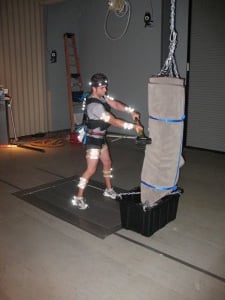
 A couple of students from the University of Waterloo are on the verge of groundbreaking research that will provide insight that can help develop or improve training programs and standards designed to minimize or prevent injury among so-called occupational athletes — firefighters, police, and the military.
A couple of students from the University of Waterloo are on the verge of groundbreaking research that will provide insight that can help develop or improve training programs and standards designed to minimize or prevent injury among so-called occupational athletes — firefighters, police, and the military.David Frost and Tyson Beach, both PhD students at the university’s Department of Kinesiology, recently came back from the Andrews Institute in Pensacola, Florida, where they had done about a year’s worth of research into the possible causes of injury among firefighters.
The Andrews Institute provided the use of its biomechanics laboratory for the two Canadian students. They worked with 60 firefighters from the Pensacola Fire Department through a rigorous testing process that involved both fitness training, movement and performance testing.
“We’re looking at ways to identify potential risks for injury, and so we screened individuals and looked at the way they move and looked at the way they activate their muscles to see if the way some people are moving might place them at greater risk (for injury),” Frost said.
The first part of the research involved movement testing, where multiple motion sensors were attached to the participants and basically recorded the subjects’ typical body movements on a daily basis.
The next part of the test was a fitness test. The firefighters were given fitness testing at the Andrews Institute laboratory. Alongside with Andrews Institute, Frost and Beach also worked with Athletes’ Performance, a training facility for competitive athletes. Athletes’ Performance provided the fitness training for the firefighters involved in the research.
“The International Association of Firefighters has some assessment standards they use across the continent and so we wanted to make sure that we incorporated everything that they are doing currently,” noted Frost.
Once the fitness training was completed, the firefighters again underwent some basic movement tests, including simulation of typical firefighter tasks, all of which were recorded through sophisticated technology using force plates, motion sensors and high-speed cameras.
 “So we treat the body just as a whole bunch of segments that are connected and then we understand where the body is in space and how these forces are acting on the body to understand really what’s going on at the tissue level,” Beach said.
“So we treat the body just as a whole bunch of segments that are connected and then we understand where the body is in space and how these forces are acting on the body to understand really what’s going on at the tissue level,” Beach said.Frost then explained the novel part of the experiment: The firefighters were divided into two controlled groups for a three-month fitness training: one focuses strictly on getting fit, and the other gives emphasis on not just getting fit but the way they move and the way they prepare the body to approach a specific task.
This is what Frost calls a paradigm shift in injury prevention among occupational athletes. “This is why Tyson (Beach) and I are involved in this and why we’re so excited about the opportunity and the potential because this new approach, looking at the way these guys move and the way they are activating their muscles, well that can dictate injury. So if we change the paradigm a little bit and not only get guys fit, but actually emphasize the way they move when they’re doing things, we think that fitness can still go up but injury rates can also go down.”
Beach and Frost are back at the University of Waterloo where they continue to work on the 10-terabytes of data they have collected from the Pensacola firefighter study group. Because this is relatively new research and due to the amount of data they have to sift through, they say it might take some time before the world can start to see some concrete conclusions.
Whether the results come sooner or later, Beach and Frost are optimistic about the study’s positive impact on injury prevention.
“A large portion of what we did is looking at these predictions or predictive type of tests,” explained Beach. “We could use that information for entry level people to really understand whether or not this person is of high-risk of injury because of their physical capabilities right now. And then we can tailor the training programs to be able to really reduce those inefficiencies or limitations to optimize their performance.” And that’s only one of the things that can come out of this study, he added.
Their work on occupational athlete injury prevention is funded by the Centre of Research Expertise for the Prevention of Musculoskeletal Disorders and the Natural Sciences and Engineering Research Council of Canada.





